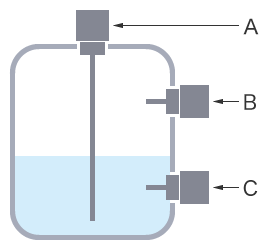Level sensors are designed to monitor liquids and powders, they're widely used in oil manufacturing plants, water treatment plants, beverage & food manufacturing companies. These devices feature radar, ultrasonic or guide pulse technology. These can be used as a simple level gauge or for accurate real-time measurement of level. They are instruments used to detect or measure the level of liquid or powder in tanks or containers. They are largely divided into level switches and level gauges.
Level switches are sensors that detect the amount of material in a container at a specific point. One type of level switch detects the level based on contact type sensors installed at the upper and lower limits of the level. Another type accurately detects the distance between the sensor head and the content in the container. This type commonly uses ultrasonic waves from inside near the top of container. Level gauges are instruments that continuously detect or measure level from inside, near the top of containers. They allow for management of the remaining amount with greater accuracy as compared with level switches. They are also called continuous level gauges, level meters, or liquid level gauges. None of these devices have moving parts which means they outlast alternative technology.

A: Level gauge transmitter(continuous level gauge), B: Level switch (for upper limit detection), C: Level switch (for lower limit detection)
Level sensors consist of any device that can be used to measure the level of a product in a particular vessel, tank, pipe or tubing. The sensors, like the non-invasive point liquid sensor, help distributors and manufacturers identify quantity of product that goes into each storage container. Point-level sensors also utilize different technologies, ranging from traditional means to gamma rays.
Importance of Level Sensors
There are many uses for point-level sensors like non-invasive point-liquid-level detectors. The primary function is to provide information regarding tank levels as a way to streamline the manufacturing processes. Companies should know how much material is in a silo or a tank to identify the amount of material needed, thereby cutting waste and getting the exact materials needed.
The robotics industry also uses point-level sensors to keep track of fluid levels. If fluid levels drop down to a certain threshold, the robotics systems can identify errors and stop operations. In the same manner, automated systems across industries rely on operations of hydraulics to identify the exact levels of oil reservoirs for maintenance and safety purposes.
Moreover, if there’s any leak in the system, the level sensor would help detect of such an issue. In this way, operations can stop before equipment fails or someone is injured. Hence, level sensors play a vital role when managing industrial operations.
Ultrasonic, and Radar Sensors:

These sensors have a sending and receiving unit, which can be transformed into a waveform. The wave travels through the fluid and measures the amount of time between sending and receiving. The detail over the time increment can then be used to measure the level of the product in the tank.
Conclusion:
Point-level sensors have broad applications in various industries. They help manufacturers and distributors monitor the amount of product filled in each storage container. The correct type of level can significantly streamline many processes.

 CN
CN


